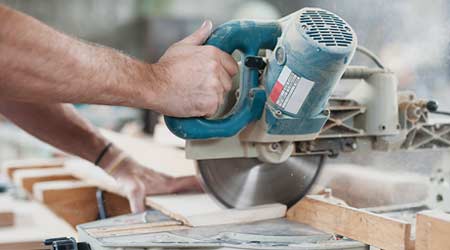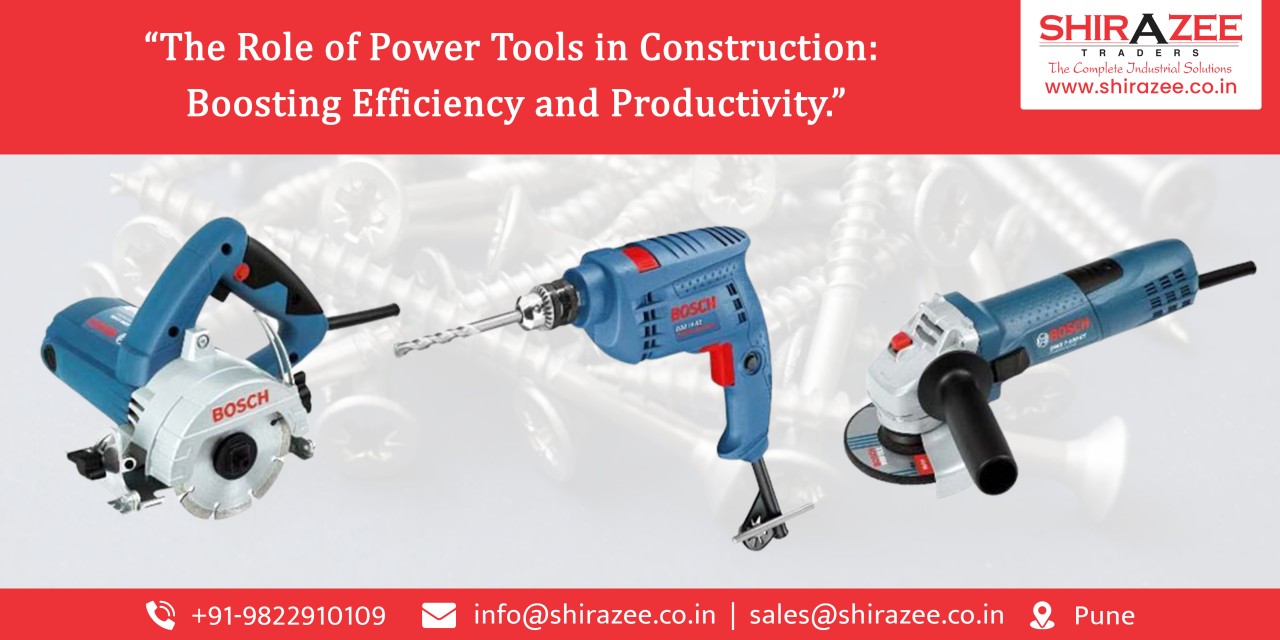If you’ve ever wondered how power tools revolutionized productivity, you’re in the right place! Power tools have had a significant impact on how things get done. So, let’s dive in and explore how these nifty gadgets have transformed the way we work.
Imagine a time when tasks like drilling, cutting, and sanding required sheer muscle power and an ocean of patience. Well, that all changed with the advent of power tools. They made these tasks quicker, easier, and way more efficient. But how exactly did power tools accomplish this? Let’s find out!
From cordless drills to electric saws, power tools are designed to make our lives easier. With their speed, precision, and versatility, they’ve become an essential part of construction, woodworking, and many other industries. But how did they come to be? And how do they work their magic? Get ready for a fascinating journey into the world of power tools!

How Power Tools Revolutionized Productivity
Power tools have played a crucial role in transforming various industries and revolutionizing productivity. From construction sites to woodworking workshops, these tools have greatly expedited tasks, saved time, and improved overall efficiency. In this article, we will explore how power tools have brought about a paradigm shift in productivity and examine the specific reasons behind their effectiveness.
The Evolution of Power Tools
The Early Days of Hand Tools
Before the advent of power tools, manual hand tools were the primary means of getting work done. While they served their purpose, these tools were limited in terms of efficiency and speed. Tasks that required strength, precision, or delicate movements often took a significant amount of time to complete. These factors hindered productivity, leading to the need for a more effective solution.
The Inception of Power Tools
The invention of power tools can be traced back to the late 19th century. The introduction of electrical motors enabled tools such as drills, saws, and sanders to be powered by electricity, resulting in a significant boost in productivity. These electric power tools eliminated the need for physical exertion, reducing the time and effort required to perform tasks. As technology continued to advance, power tools evolved further, becoming more compact, lightweight, and portable, allowing for greater versatility and ease of use.
The Impact on Productivity
The introduction of power tools revolutionized productivity in various industries. Whether it be construction, woodworking, or metalworking, the efficiency gains brought by power tools cannot be overstated. Tasks that once took hours or even days to complete can now be done in a fraction of the time with greater precision. This has resulted in increased output, faster project completion, and ultimately, improved profitability for businesses.
The Benefits of Power Tools in Different Industries
Construction Industry
The construction industry has greatly benefited from the introduction of power tools. Tasks such as drilling holes, driving screws, and cutting materials can now be accomplished swiftly and accurately with the aid of power tools. This has led to shorter construction timelines, reduced labor costs, and higher quality workmanship. Power tools have also improved safety on construction sites by minimizing the risks associated with manual tools.
Woodworking Industry
In the woodworking industry, power tools have transformed the way artisans and craftsmen work. Traditional tasks like cutting, shaping, and sanding large wooden pieces have become significantly easier and faster with power saws, routers, and sanders. These tools allow for precise cuts, intricate designs, and smoother finishes, which were difficult to achieve using hand tools alone. As a result, woodworking projects can be completed with greater efficiency, allowing craftsmen to take on more projects and expand their business.
Automotive Industry
Power tools have also had a significant impact on the automotive industry. From assembly lines to repair shops, power tools have become indispensable in tasks such as tightening bolts, removing nuts, and cutting materials. These tools save time and effort, allowing mechanics and technicians to work more efficiently. The increased productivity and precision provided by power tools have ultimately led to faster vehicle production, shorter repair times, and improved customer satisfaction.
Power Tools and Safety
Safety Features
Power tools have come a long way in terms of safety features. Manufacturers have implemented various safety mechanisms to reduce the risk of accidents and injuries. Features such as safety guards, anti-kickback systems, and blade brakes provide protection to users and minimize the chances of mishaps. It is crucial for users to familiarize themselves with these safety features and follow proper operating procedures to ensure safe and effective use of power tools.
Protective Gear
When using power tools, it is essential to prioritize personal safety by wearing appropriate protective gear. Safety glasses, gloves, ear protection, and dust masks are some of the commonly used protective equipment. These items help prevent injuries and minimize exposure to noise, dust, and debris. It is important to select the right gear for the specific task at hand and always prioritize safety above all else.
Proper Training
To ensure optimal safety and productivity, proper training is essential when using power tools. Users should receive adequate training on how to operate the tools correctly, understand their limitations, and troubleshoot any issues that may arise. This training helps minimize the risk of accidents and ensures that power tools are being used effectively and efficiently.
Key Takeaways: How Did Power Tools Increase Productivity?
- Power tools revolutionized the way work is done, making tasks faster and more efficient.
- They enable workers to complete jobs in less time, resulting in increased productivity.
- Power tools reduce physical strain on workers, allowing them to work for longer periods without exhaustion.
- These tools are designed with advanced features that improve accuracy and precision in various tasks.
- Overall, power tools have transformed industries by enhancing productivity, reducing labor costs, and improving job outcomes.
Frequently Asked Questions
Welcome to our Frequently Asked Questions section where we will explore how power tools have increased productivity. Power tools have revolutionized numerous industries, making tasks faster, easier, and more efficient. Let’s dive into some common questions related to this topic.
How have power tools improved productivity in construction?
Power tools have greatly enhanced productivity in the construction industry. With the introduction of tools such as power drills, nail guns, and circular saws, workers can complete tasks in a fraction of the time it would take with traditional hand tools. These power tools allow for faster and more precise work, resulting in increased efficiency and productivity on construction sites. Additionally, power tools enable workers to handle heavy-duty tasks with less physical exertion, reducing fatigue and allowing for longer periods of work.
Moreover, power tools often come with features such as adjustable speed, torque control, and precision settings, which provide greater control and flexibility. This means that workers can adapt to various project requirements swiftly, leading to increased productivity and improved overall performance in the construction industry.
How have power tools impacted manufacturing productivity?
The impact of power tools on manufacturing productivity is significant. These tools have streamlined various processes, resulting in faster production rates. For example, automated power tools like robotics have revolutionized assembly lines by performing repetitive tasks with unparalleled speed and accuracy. This automation reduces the need for manual labor and eliminates human error, ultimately leading to increased productivity.
Furthermore, power tools in manufacturing also ensure consistent quality. They aid in precision cutting, shaping, and drilling, which is crucial for producing standardized components. With power tools, manufacturers can achieve higher levels of precision, resulting in fewer defects and higher product quality. This not only reduces waste but also saves time and resources, greatly boosting overall productivity in the manufacturing sector.
How have power tools contributed to increased productivity in the automotive industry?
The automotive industry has greatly benefited from the use of power tools, which have significantly increased productivity. Power tools like pneumatic wrenches, impact drivers, and air compressors have streamlined various tasks such as tire mounting, engine assembly, and vehicle repair. The speed and efficacy of these power tools have drastically reduced the time it takes to complete these tasks, resulting in improved productivity in automotive workshops and assembly lines.
Additionally, power tools have improved the precision and quality of work in the automotive industry. Computer-controlled power tools, for instance, have helped achieve accurate torque specifications during vehicle assembly, reducing the risk of loosened or overtightened fasteners. This level of precision not only ensures safer and more reliable vehicles but also contributes to increased productivity by minimizing rework and repairs.
How have power tools impacted woodworking productivity?
Power tools have revolutionized the woodworking industry, significantly increasing productivity. Tools like power saws, routers, and sanders make it easier and faster to shape, cut, and smoothen wood. These tools allow craftsmen to achieve more intricate designs, precise cuts, and smooth finishes in a fraction of the time compared to traditional hand tools.
Power tools have also simplified complex woodworking tasks, such as jointing, planing, and carving. They provide greater control and consistency, resulting in higher-quality output and reduced waste. Moreover, power tools in woodworking minimize physical strain and fatigue on craftsmen, enabling them to work more efficiently for longer periods, ultimately boosting productivity.
How have power tools increased productivity in the gardening and landscaping industry?
Power tools have had a significant impact on productivity in the gardening and landscaping industry. Tools such as lawn mowers, hedge trimmers, and leaf blowers have drastically reduced the time and effort required to maintain outdoor spaces. With power tools, tasks that used to take hours to complete can now be done in a fraction of the time, resulting in increased productivity.
Furthermore, power tools in gardening and landscaping allow for more precise and consistent results. For example, power trimmers help achieve uniform hedges and neatly edged lawns, enhancing the overall aesthetics of the outdoor space. The speed and efficiency of power tools enable workers to handle larger areas and complete tasks more rapidly, further contributing to increased productivity in the gardening and landscaping industry.
The Only 3 PRODUCTIVITY TOOLS You’ll EVER Need
Summary
Power tools have made work easier and faster, increasing productivity in various industries. They are efficient and save time by automating tasks that used to be done manually. Power tools also allow workers to handle heavy tasks with less physical effort, reducing fatigue and improving efficiency. Moreover, power tools offer precision and accuracy, ensuring high-quality results and minimizing errors. They have revolutionized industries like construction, manufacturing, and woodworking, boosting productivity and enabling the completion of complex projects in less time. With the advancements in power tool technology, we can expect even greater improvements in productivity in the future.
In conclusion, power tools have immensely contributed to the increase in productivity by streamlining work processes, reducing physical strain, and ensuring precision in various industries. Their impact continues to be significant and will only grow with future innovations. So if you’re looking to get things done faster and more efficiently, power tools are definitely a valuable investment.

